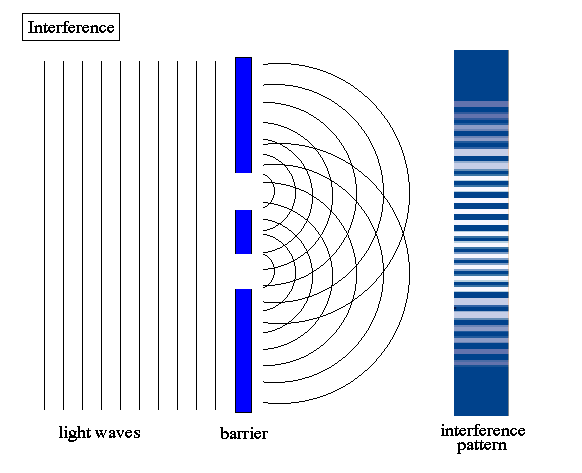
|
The wave-like properties of light were demonstrated by the famous experiment first performed by Thomas Young in the early nineteenth century. In original experiment, a point source of light illuminates two narrow adjacent slits in a screen, and the image of the light that passes through the slits is observed on a second screen. |

.. |
.. The dark and light regions are called interference fringes, the constructive and destructive interference of light waves. So the question is will matter also produce interference patterns. The answer is yes, tested by firing a stream of electrons. ..  |
.. |
.. However, notice that electrons do act as particles, as do photons. For example, they make a single strike on a cathode ray tube screen. So if we lower the number of electrons in the beam to, say, one per second. Does the interference pattern disappear? .. 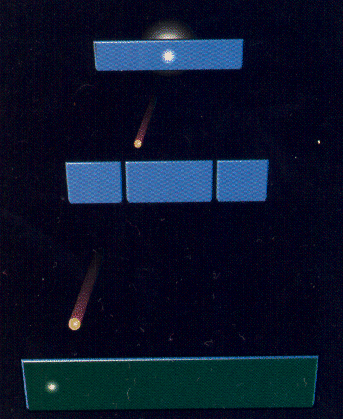 |
.. |
.. The answer is no, we do see the individual electrons (and photons) strike the screen, and with time the interference pattern builds up. Notice that with such a slow rate, each photon (or electron) is not interacting with other photons to produce the interference pattern. In fact, the photons are interacting with themselves, within their own wave packets to produce interference. .. 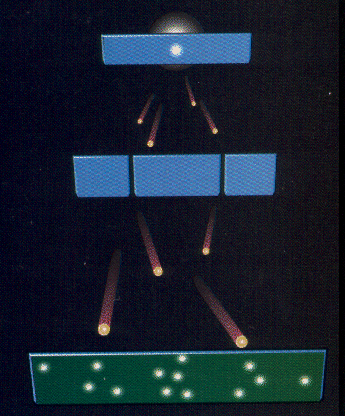 |
.. |
.. But wait, what if we do this so slow that only one electron or one photon passes through the slits at a time, then what is interfering with what? i.e. there are not two waves to destructively and constructively interfere. It appears, in some strange way, that each photon or electron is interfering with itself. That its wave nature is interfering with its own wave (!). .. .. The formation of the interference pattern requires the existence of two slits, but how can a single photon passing through one slit `know' about the existence of the other slit? We are stuck going back to thinking of each photon as a wave that hits both slits. Or we have to think of the photon as splitting and going through each slit separately (but how does the photon know a pair of slits is coming?). The only solution is to give up the idea of a photon or an electron having location. The location of a subatomic particle is not defined until it is observed (such as striking a screen). |
|
The quantum world can be not be perceived
directly, but rather through the use of instruments. And, so, there is a
problem with the fact that the act of measuring disturbs the energy and
position of subatomic particles. This is called the measurement problem.
.. 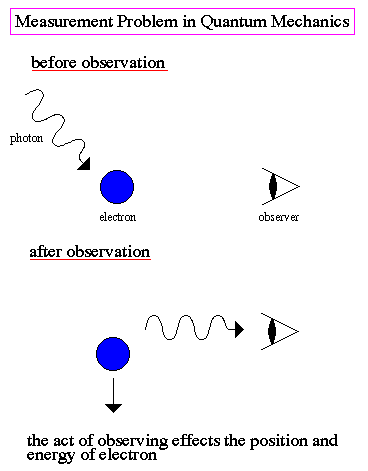 |
.. |
.. Thus, we begin to see a strong coupling of the properties of an quantum object and and the act of measuring those properties. The question of the reality of quantum properties remains unsolved. All quantum mechanical principles must reduce to Newtonian principles at the macroscopic level (there is a continuity between quantum and Newtonian mechanics). .. How does the role of the observer effect the wave and particle nature of the quantum world? One test is to return to the two slit experiment and try to determine count which slit the photon goes through. If the photon is a particle, then it has to go through one or the other slit. Doing this experiment results in wiping out the interference pattern. The wave nature of the light is eliminated, only the particle nature remains and particles cannot make interference patterns. Clearly the two slit experiments, for the first time in physics, indicates that there is a much deeper relationship between the observer and the phenomenon, at least at the subatomic level. This is an extreme break from the idea of an objective reality or one where the laws of Nature have a special, Platonic existence. .. 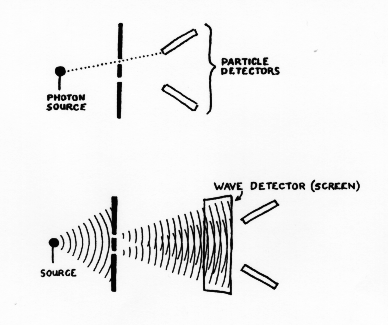 .. If the physicist looks for a particle (uses particle detectors), then a particle is found. If the physicist looks for a wave (uses a wave detector), then a wave pattern is found. A quantum entity has a dual potential nature, but its actual (observed) nature is one or the other. |
|
The wave nature of the microscopic world
makes the concept of `position' difficult for subatomic particles. Even a
wave packet has some `fuzziness' associated with it. An electron in orbit
has no position to speak of, other than it is somewhere in its orbit.
.. To deal with this problem, quantum physics developed the tool of the quantum wave function as a mathematical description of the superpositions associated with a quantum entity at any particular moment. |
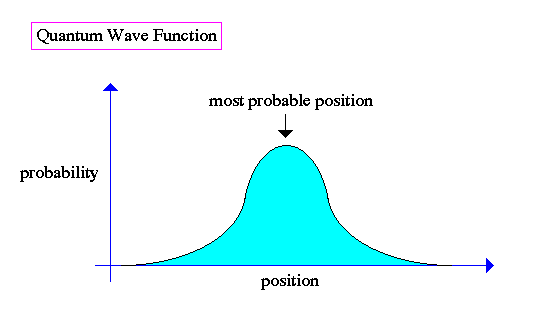
.. |
.. The key point to the wave function is that the position of a particle is only expressed as a likelihood or probability until a measurement is made. For example, striking an electron with a photon results in a position measurement and we say that the wave function has `collapsed' (i.e. the wave nature of the electron converted to a particle nature). |
|
The fact that quantum systems, such as
electrons and protons, have indeterminate aspects means they exist as
possibilities rather than actualities. This gives them the property of
being things that might be or might happen, rather than things that are.
This is in sharp contrast to Newtonian physics where things are or are
not, there is no uncertainty except those imposed by poor data or
limitations of the data gathering equipment.
.. Further experimentation showed that reality at the quantum (microscopic) level consists of two kinds of reality, actual and potential. The actual is what we get when we see or measure a quantum entity, the potential is the state in which the object existed before it was measured. The result is that a quantum entity (a photon, electron, neutron, etc) exists in multiple possibilities of realities known as superpositions. .. The superposition of possible positions for an electron can be demonstrated by the observed phenomenon called quantum tunneling. |
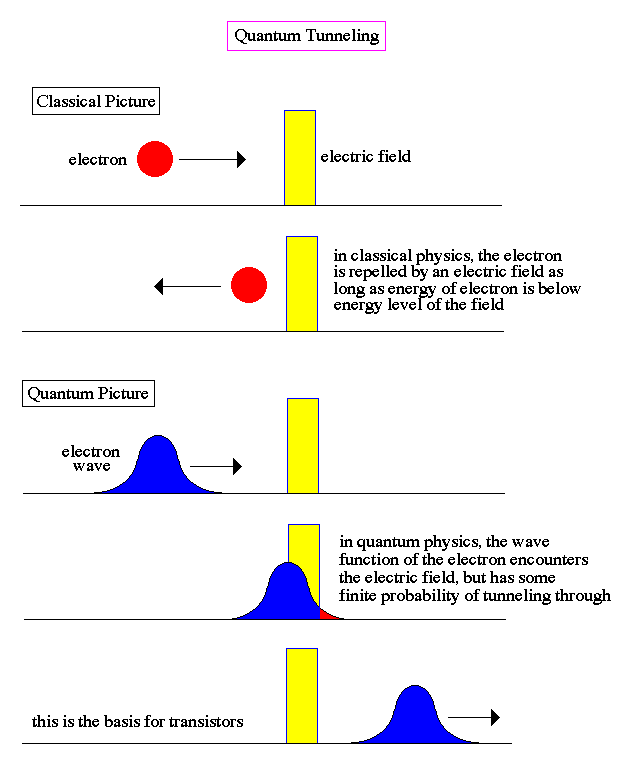
.. |
.. Notice that the only explanation for quantum tunneling is if the position of the electron is truly spread out, not just hidden or unmeasured. Raw uncertainty allows for the wave function to penetrate the barrier. This is genuine indeterminism, not simply an unknown quantity until someone measures it. .. It is important to note that the superposition of possibilities only occurs before the entity is observed. Once an observation is made (a position is measured, a mass is determined, a velocity is detected) then the superposition converts to an actual. Or, in quantum language, we say the wave function has collapsed. |
.. |
.. The collapse of the wave function by observation is a transition from the many to the one, from possibility to actuality. The identity and existence of a quantum entities are bound up with its overall environment (this is called contextualism). Like homonyms, words that depend on the context in which they are used, quantum reality shifts its nature according to its surroundings. .. In the macroscopic world ruled by classical physics, things are what they are. In the microscopic world ruled by quantum physics, there is an existential dialogue among the particle, its surroundings and the person studying it. |